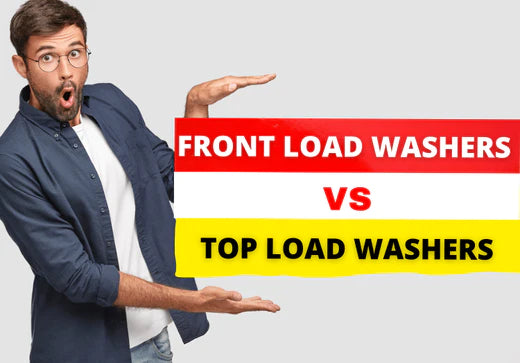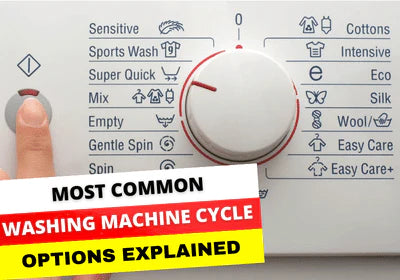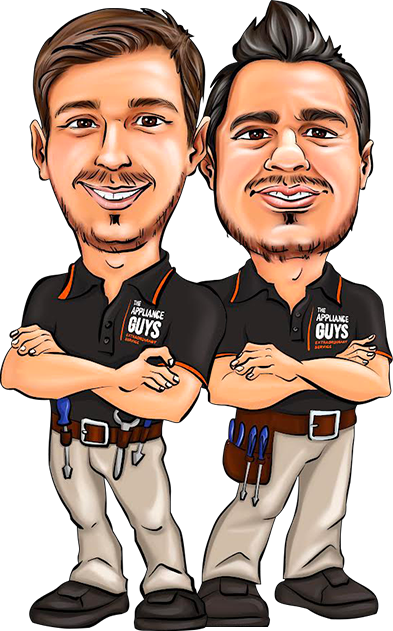Front Load vs Top Load Washing Machine
The washing machines history dates back to the 1800s, when people began experimenting with ways to wash clothes more efficiently. In 1851, American inventor Hamilton Smith built the first washing machine prototype, which used a rotary drum and hand-powered crank to agitate the clothes. In the decades that followed, other inventors developed more advanced washing machines that used steam and electric power. However it wasn’t until the 1950s that washing machines really started to catch on in people’s homes across the world, with top loaders gaining popularity in Australia and the US, and front loaders leading the pack in Europe.
After seven decades of innovations we still have two main types of washing machines which are the front-load and top-load washing machines. Front-Load Washing Machines are installed with the door to the wash compartment facing the front of the machine, and they have a horizontal axis with the drum lying horizontally. Top-Load Washing Machines, on the other hand, are installed with the door to the wash compartment facing the top of the machine, and they have a vertical axis with the drum standing upright. These are the main types of washing machines, and they are distinguished by their design. We also aim to answer the following questions so that Aussies have a better understanding on the differences.
-
- How do front-load washing machines work?
-
- How do top-load washing machines work?
-
- Which washing machine type performs better?
-
- Which washing machine type provides a quicker wash?
-
- Which washing machine type is better priced?
-
- Which washing machine type is more energy efficient?
-
- What are the top-load washing machines' cons?
-
- What to look for in a top-load washing machine??
-
- What to look for in a front-load washing machine?
How do front-load washing machines work?
Front-load washing machines are clothes washers designed to operate with the door to the washing tub located on the front of the machine. Front-load washing machines fill the tub with water and detergent, then use a spinning motion to agitate the clothes and clean them. To use a front-load washing machine, you first load your clothes into the tub. Then, you add the appropriate amount of detergent and select the wash cycle you want. Next, the machine will fill the tub with water and start to agitate the clothes using a spinning motion. This motion helps to loosen and remove dirt and stains from the clothes.
During the wash cycle, the water in the tub is drained, and freshwater is added to rinse the clothes. After the rinse cycle is complete, the machine will spin the clothes again to remove excess water. Once the wash cycle is finished, you can open the door and remove the clean clothes from the tub. Overall, front-load washing machines are designed to provide an efficient and effective way to clean clothes. In addition, they use less water and energy than traditional top-load washing machines, making them a more environmentally-friendly option.
How do top-load washing machines work?
Top-load washing machines are a type of washing machine that is commonly found in Australian households. They are called top-load because the clothes are loaded into the machine from the top rather than from the front, as with front-load washing machines. There are two main types of top-load washing machines: those with agitators and high-efficiency models without agitators. The main difference between the two is how they wash the clothes. Top-load washing machines with agitators have a vertical pole in the centre of the wash drum. This agitator moves back and forth, churning the clothes and water to create a washing action. This can be effective at cleaning clothes, but it can also be rough on fabrics and cause them to wear out more quickly.
On the other hand, high-efficiency top-load washing machines do not have agitators. Instead, they use impellers, which are small, rotating blades that create a gentle washing action. This is gentler on fabrics and can help them last longer, but it may be less effective at removing tough stains. The choice between a top-load washing machine with an agitator and a high-efficiency model without an agitator will depend on your specific needs and preferences.
Which washing machine type performs better?
It is difficult to say which type of washing machine performs better overall, as the performance of a washing machine can depend on various factors such as the model and brand, the type of clothes being washed, and the specific washing cycle being used. In general, however, front-load washing machines tend to be more energy efficient and can be gentler on clothes than top-load washing machines.
Front-load washing machines are more energy efficient because they use gravity to move the clothes through the wash cycle, rather than an agitator or impeller. This means that they use less water and electricity, which can save money on utility bills and reduce their environmental impact. Front-load washing machines are also typically larger and can hold more clothes than top-load washing machines, making them more convenient for larger loads.
Additionally, front-load washing machines are gentler on clothes because they do not have an agitator. The agitator in a top-load washing machine can be rough on fabrics and cause them to wear out more quickly, whereas the tumbling action of a front-load washing machine is gentler and can help clothes last longer.
Of course, there are also some drawbacks to front-load washing machines. For example, they can be more expensive than top-load washing machines and more difficult to load and unload because the door is located on the front of the machine. Additionally, some people find it harder to clean because of the small space between the door and the drum.
Overall, whether a front-load or top-load washing machine is better for you will depend on your specific needs and preferences. It is always a good idea to research and compare different models and brands to find the one that is right for you.
Which washing machine type provides a quicker wash?
Front-load and top-load washing machines are designed to clean clothes effectively, but they may have different wash times depending on the specific model and the wash cycle you use. Front-load washing machines generally provide quicker wash times than top-load washing machines.
Front-load washing machines have shorter wash times because they use a more efficient cleaning method. Front-load washing machines use a tumbling motion to clean clothes, allowing better water and detergent penetration into the fabrics. This can result in faster and more thorough cleaning, leading to shorter wash times.
In contrast, top-load washing machines use a more traditional agitator to clean clothes. This method can be less efficient and may require longer wash times to achieve the same level of cleaning as a front-load washing machine.
Of course, the actual wash times for a specific front-load or top-load washing machine will vary depending on the model and the wash cycle you use. Therefore, it's always a good idea to consult the manufacturer's instructions or manual to get specific wash time information for a particular model.
Which washing machine type is better priced?
The price of front-load and top-load washing machines can vary depending on several factors, such as the machine's brand, size, and features. However, top-load washing machines are typically more affordable than front-load washing machines.
One reason top-load washing machines are often less expensive is that they have a more straightforward design and fewer moving parts. This makes them less costly to manufacture and sell, resulting in lower consumer prices, while in contrast, the front-load washing machines are more complex and have more moving parts, making them more expensive to manufacture and sell, resulting in higher consumer prices.
Of course, the actual prices of front-load and top-load washing machines will vary depending on the specific models and features you are looking at. Therefore, shopping around and comparing prices from different retailers and brands is always a good idea to find the best deal. Additionally, remember a higher-priced washing machine may offer more features, better energy efficiency, or a longer lifespan, which could make it a better value in the long run.
Which washing machine type is more energy efficient?
Front-load washing machines are generally more energy efficient than top-load washing machines. This is because front-load washing machines use a more efficient cleaning method and have more advanced features that can help save energy.
One reason front-load washing machines are more energy efficient is that they use a tumbling motion to clean clothes rather than an agitator. This method allows for better water and detergent penetration into the fabrics, which can result in faster and more thorough cleaning. As a result, front-load washing machines can often use lower water and energy levels to achieve the same level of cleaning as a top-load washing machine.
Additionally, front-load washing machines often have more advanced features that can help save energy. For example, many front-load washing machines have a feature called "cold wash" or "cold water wash," which allows you to clean your clothes using cold water rather than hot water. This can save a significant amount of energy, as heating water is one of the biggest energy demands of a washing machine.
If energy efficiency is a top concern, a front-load washing machine may be the better choice. However, it's always a good idea to compare the specific energy efficiency ratings of the models you are considering to ensure you are getting the most efficient machine possible.
Which washing machine type is more water efficient?
Front-load washing machines are more water-efficient than top-load washing machines because they use gravity to move the clothes through the wash cycle, so they do not require as much water to operate. In contrast, top-load washing machines often have an agitator or impeller that moves the clothes through the water, which can need more water to use.
Additionally, front-load washing machines are typically larger and can hold more clothes than top-load washing machines, which means that they can be more efficient for larger loads. This can also help to save water because you can wash more clothes at once and therefore do fewer loads of laundry.
Of course, the water efficiency of a washing machine can also depend on factors such as the specific model and brand, the type of clothes being washed, and the particular washing cycle being used. Therefore, it is always a good idea to research and compare different models and brands to find the one that is right for you.
Which washing machine type has more functions and features?
Front-load washing machines typically have more functions and features than top-load washing machines. This is because front-load washing machines are more complex and have more advanced technology, which allows for a broader range of functions and features.
One reason front-load washing machines have more functions and features is that they use a tumbling motion to clean clothes rather than an agitator. This method allows for better water and detergent penetration into the fabrics, which can result in faster and more thorough cleaning. As a result, front-load washing machines can often offer more wash cycles and options to fine-tune the wash process for different clothes and stains.
Additionally, front-load washing machines often have more advanced features, such as steam cleaning, sanitizing, and allergy-reducing cycles. These features can help improve the machine's cleaning performance and provide additional benefits for your clothes and laundry.
Overall, a front-load washing machine may be the better choice if you are looking for a washing machine with a wide range of functions and features. However, it's always a good idea to compare the specific features and functions of the models you are considering to make sure you are getting the machine that best meets your needs.
What are the front-load washing machine pros?
Front-load washing machines have several advantages over top-load washing machines. Some of the main pros of front-load washing machines include:
More Energy Efficient: Front-load washing machines are more energy efficient than top-load washing machines because they use gravity to move the clothes through the wash cycle, rather than an agitator or impeller. This means that they use less water and electricity, which can save money on utility bills and reduce their environmental impact.
Gentler on Clothes: Front-load washing machines are gentler on clothes than top-load washing machines because they do not have an agitator. The agitator in a top-load washing machine can be rough on fabrics and cause them to wear out more quickly, whereas the tumbling action of a front-load washing machine is gentler and can help clothes last longer.
More Convenient for Larger Loads: Front-load washing machines are typically larger and can hold more clothes than top-load washing machines, which can be more suitable for larger loads. This can save time and effort by allowing you to wash more clothes at once.
Better Cleaning Performance: Front-load washing machines are generally considered to have better cleaning performance than top-load washing machines. This is because the tumbling action of the front-load washing machine is more effective at removing dirt and stains from clothes.
Overall, front-load washing machines have many advantages over top-load washing machines, including being more energy efficient, gentler on clothes, and more convenient for larger loads.
What are the front-load washing machine cons?
Front-load washing machines are generally more energy and water efficient than top-load washing machines, but they can be more expensive to purchase upfront. Due to their design, they also require special detergents and can be more challenging to load and unload. In addition, some people may find the top of the machine a convenient spot to place laundry items, but this is not possible with a front-load washing machine. Finally, if not correctly maintained, front-load washing machines can sometimes develop mould or mildew.
What are the top-load washing machines pros?
Top-load washing machines have many pros and advantages compared to other types. Some of the top pros of top-load washing machines include the following:
Affordability: Top-load washing machines are generally more affordable than front-load washing machines, making them a good option for people on a budget.
Ease of Use: Top-load washing machines are often easier than front-load washing machines because you don't have to bend down to load and unload the clothes. This can be especially helpful for people with back or mobility issues.
Larger Capacity: Because top-load washing machines have a vertical orientation, they often have a larger capacity than front-load washing machines of the same size. This can be useful if you have a lot of laundry or large items, such as comforters or blankets.
Faster Wash Times: Some top-load washing machines are designed to have faster wash times than front-load washing machines, which can be helpful if you need to wash a lot of clothes quickly.
Overall, top-load washing machines have several pros, making them a popular choice.
What are the top-load washing machines' cons?
Top-load washing machines also have some cons or disadvantages compared to other types of washing machines. Some of the top cons of top-load washing machines include:
Less Energy Efficient: Top-load washing machines are generally less energy efficient than front-load washing machines because they use a less efficient cleaning method and have fewer advanced features. This can lead to higher energy bills and more impact on the environment.
Less Gentle on Clothes: Because top-load washing machines use an agitator to clean clothes, they can be rougher on fabrics than front-load washing machines. This can cause clothes to wear out faster and may concern people with delicate or expensive garments.
More Difficult to Clean: Because top-load washing machines have an agitator in the centre of the tub, it can be challenging to clean the inside. This can lead to a build-up of dirt, grime, and bacteria, which can affect the cleanliness and freshness of your laundry.
Shorter Lifespan: Top-load washing machines generally have a shorter lifespan than front-load washing machines because they have more moving parts and are subject to more wear and tear. This can result in the need for more frequent repairs and replacements, which can be costly over the long term.
Overall, while top-load washing machines have some advantages, they also have disadvantages that you should consider before purchasing.
What to look for in a top-load washing machine?
When shopping for a top-load washing machine, there are a few key things to consider to make sure you choose the best model for your needs. Some of the most important things to look for in a top-load washing machine include:
Capacity: The capacity of a top-load washing machine refers to the maximum weight of clothes it can handle in a single wash cycle. Make sure to choose a model with a capacity that is suitable for your laundry needs.
Energy efficiency: Top-load washing machines are generally less energy efficient than front-load washing machines, so choosing a model with a good energy efficiency rating is essential. Look for a machine with an Energy Star certification or other energy-saving features to save money on your utility bills and reduce your environmental impact.
Features & Functions: Top-load washing machines have various features and functions, such as different wash cycles, automatic dispensers, and delay start options. Consider which features are most important to you and choose a model that offers the functions you need.
Price & Value: The cost of a top-load washing machine can vary depending on the brand, size, and features. Make sure to compare prices from different retailers and consider the overall value of the machine, taking into account factors such as energy efficiency, durability, and warranty.
What to look for in a front-load washing machine?
When shopping for a front-load washing machine, there are several important factors to consider. First, think about the size of the washing machine and the capacity it offers. A larger capacity means you can wash more laundry in a single load, saving time and energy. However, a larger washing machine will also take up more space in your home and may be more expensive. Therefore, it's a good idea to consider your laundry needs and the space available in your home before choosing a front-load washing machine.
Next, consider the features and functions of the washing machine. Look for a model with a range of wash cycles and options, such as a delicates cycle, a heavy-duty cycle, and a quick wash cycle. In addition, some front-load washing machines have additional features, such as sanitizing, delay start and steam cleaning like the Beko BFL7510W.
Another essential factor to consider is energy efficiency. Front-load washing machines are generally more energy efficient than top-load washing machines, but some models are more efficient than others. Look for a washing machine with an Energy Star rating, which indicates that it meets strict energy efficiency standards.
Finally, consider the price of the washing machine and the warranty offered by the manufacturer. A more expensive model may have more features and a longer warranty, but choosing a washing machine that fits your budget and meets your needs is important. It's also a good idea to read customer reviews and compare different models before purchasing.






















































